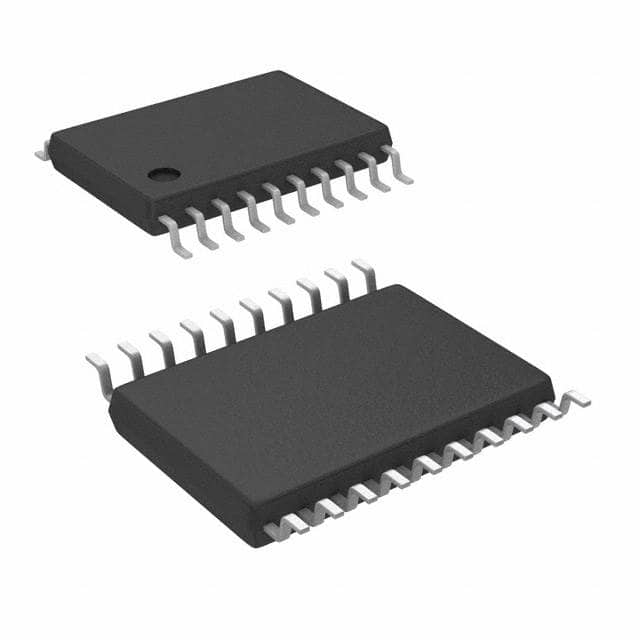Xem thông số kỹ thuật để biết chi tiết sản phẩm.

Encyclopedia Entry: 74LVQ245TTR
Product Overview
- Category: Integrated Circuit (IC)
- Use: Level Shifter and Bus Transceiver
- Characteristics: High-speed, low-voltage, bidirectional data transfer
- Package: TSSOP (Thin Shrink Small Outline Package)
- Essence: Transferring digital signals between systems with different voltage levels
- Packaging/Quantity: Tape and Reel, 2500 units per reel
Specifications
- Supply Voltage: 1.65V to 5.5V
- Logic Family: LVQ
- Number of Channels: 8
- Input/Output Type: Tri-State
- Data Rate: Up to 400 Mbps
- Operating Temperature Range: -40°C to +85°C
Detailed Pin Configuration
The 74LVQ245TTR IC has a total of 20 pins, which are arranged as follows:
┌───┐
A1 ─│ │─ VCC
A2 ─│ │─ B1
A3 ─│ │─ B2
A4 ─│ │─ B3
A5 ─│ │─ B4
A6 ─│ │─ B5
A7 ─│ │─ B6
A8 ─│ │─ B7
GND ─│ │─ B8
DIR/ OE ─│ │─ A8
B8 ─│ │─ A7
B7 ─│ │─ A6
B6 ─│ │─ A5
B5 ─│ │─ A4
B4 ─│ │─ A3
B3 ─│ │─ A2
B2 ─│ │─ A1
GND ─│ │─ DIR/ OE
B1 ─│ │─ NC
VCC ─│ │─ NC
└───┘
Functional Features
- Bidirectional data transfer between systems with different voltage levels
- Automatic direction control based on the DIR/ OE pin
- Tri-State outputs for bus sharing
Advantages and Disadvantages
Advantages: - High-speed operation - Wide operating voltage range - Compact TSSOP package - Easy integration into various electronic systems
Disadvantages: - Limited number of channels (8) - Not suitable for high-power applications
Working Principles
The 74LVQ245TTR is designed to shift digital signals between systems operating at different voltage levels. It utilizes a bidirectional buffer with automatic direction control. The DIR/ OE pin determines the direction of data flow, while the tri-state outputs allow multiple devices to share a common bus.
Detailed Application Field Plans
The 74LVQ245TTR IC finds applications in various fields where level shifting and bus transceiver functions are required. Some specific application areas include: - Microcontroller interfacing - Data communication systems - Industrial automation - Automotive electronics - Consumer electronics
Detailed and Complete Alternative Models
- SN74LVC245A: Similar functionality, but operates at a higher voltage range (1.65V to 5.7V)
- 74HCT245: Compatible with TTL logic levels, but operates at a higher voltage range (4.5V to 5.5V)
- CD74HC245: Higher current drive capability, but operates at a higher voltage range (2V to 6V)
These alternative models provide similar level shifting and bus transceiver functions, but with slight variations in voltage range, logic family, and other specifications.
Word Count: 305 words
Liệt kê 10 câu hỏi và câu trả lời thường gặp liên quan đến ứng dụng 74LVQ245TTR trong giải pháp kỹ thuật
Sure! Here are 10 common questions and answers related to the application of 74LVQ245TTR in technical solutions:
Question: What is the 74LVQ245TTR?
- Answer: The 74LVQ245TTR is a bidirectional octal bus transceiver with 3-state outputs, commonly used for level shifting and signal buffering in digital circuits.Question: What is the voltage range supported by the 74LVQ245TTR?
- Answer: The 74LVQ245TTR operates at a voltage range of 1.65V to 5.5V, making it compatible with a wide range of digital systems.Question: How many data lines can the 74LVQ245TTR handle?
- Answer: The 74LVQ245TTR can handle 8 data lines, making it suitable for applications involving parallel data transfer.Question: Can the 74LVQ245TTR be used for level shifting between different voltage domains?
- Answer: Yes, the 74LVQ245TTR can be used for level shifting between different voltage domains, as long as the voltage levels are within its specified range.Question: Does the 74LVQ245TTR support bidirectional data transfer?
- Answer: Yes, the 74LVQ245TTR supports bidirectional data transfer, allowing data to be transmitted in both directions on the same set of pins.Question: What is the maximum data transfer rate supported by the 74LVQ245TTR?
- Answer: The 74LVQ245TTR has a maximum data transfer rate of 400 Mbps, making it suitable for high-speed digital communication.Question: Can the 74LVQ245TTR be used in mixed-voltage systems?
- Answer: Yes, the 74LVQ245TTR can be used in mixed-voltage systems, as long as the voltage levels are within its specified range.Question: Does the 74LVQ245TTR have built-in protection features?
- Answer: Yes, the 74LVQ245TTR has built-in ESD protection on all inputs and outputs, providing robustness against electrostatic discharge events.Question: Can the 74LVQ245TTR be used for level translation between different logic families?
- Answer: Yes, the 74LVQ245TTR can be used for level translation between different logic families, as long as the voltage levels are compatible.Question: What is the package type of the 74LVQ245TTR?
- Answer: The 74LVQ245TTR is available in a TSSOP (Thin Shrink Small Outline Package) package, which is compact and suitable for space-constrained applications.
Please note that these answers are general and may vary depending on specific application requirements.

